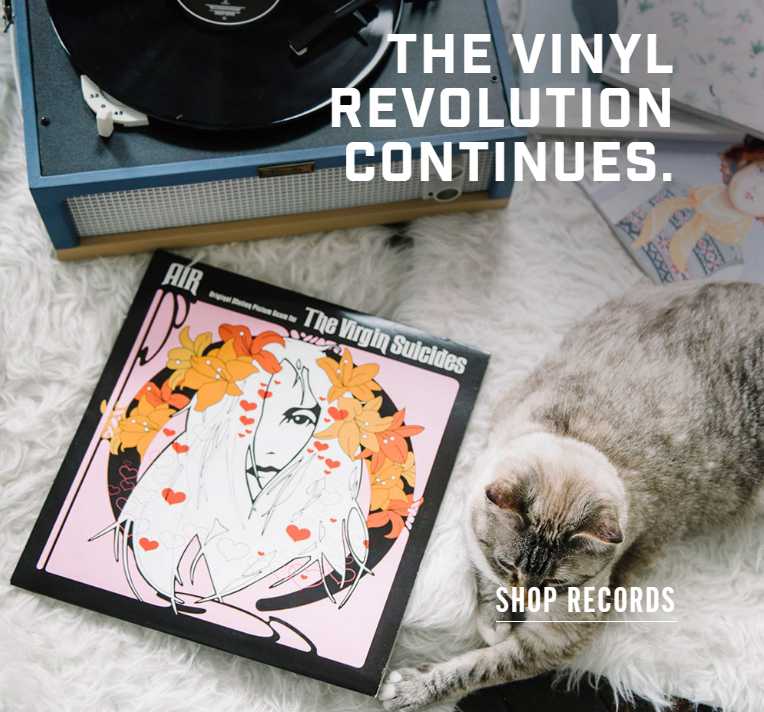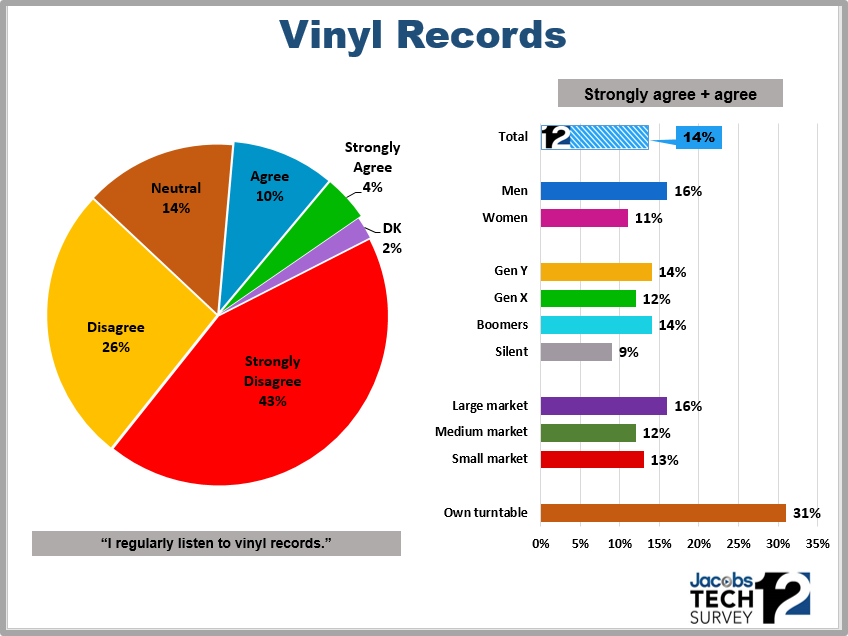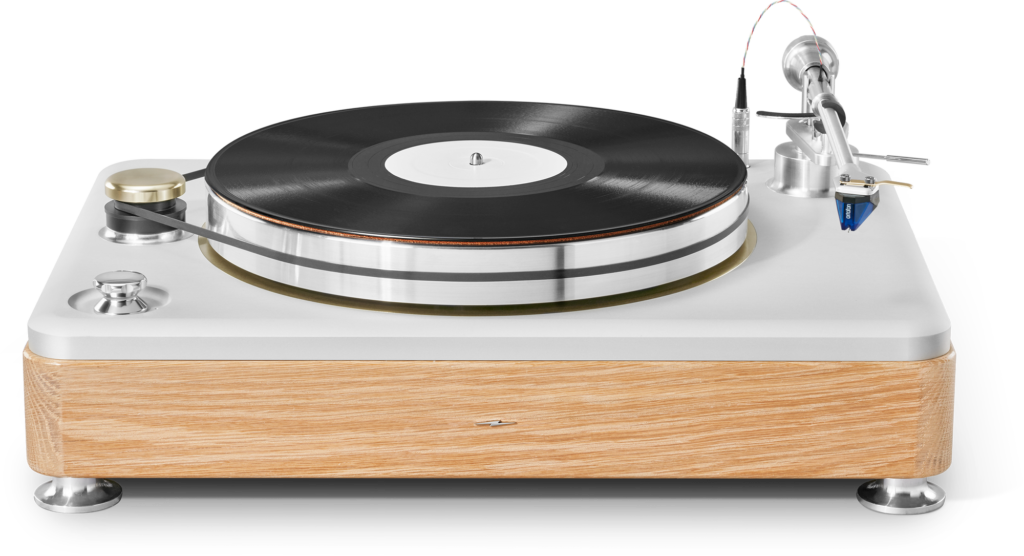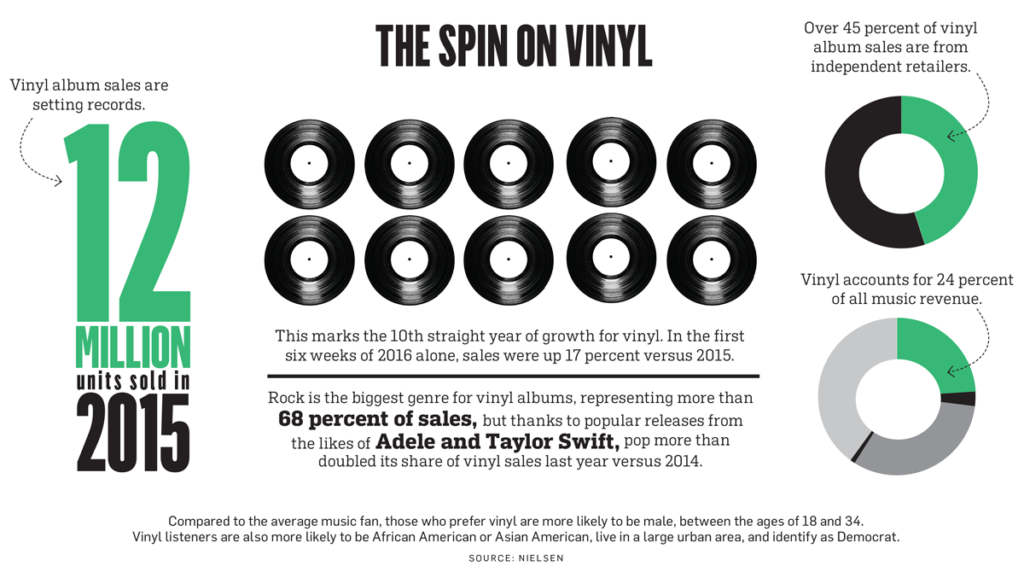
We recently sent out a client advisory about cool stocking stuffers this holiday season. While we mentioned a number of great gifts, we’re certainly expecting there will be a few million more Amazon Echoes on coffee tables come January. But before we jump on the voice command bandwagon this year, let’s not forget about a very “old school” product that continues to amaze and astound…
The turntable and its proprietary software, vinyl records, have morphed from near extinction to become premium products.
That’s an amazing turn of events, given that turntables had become about as commonplace as Walkmans and boomboxes. And just as improbably, it’s Millennial guys that are leading the turntable turnaround.
We’re seeing it in the ethnographic interviews with Millennials we’re conducting all over the U.S. The “Millennial Research Project,” sponsored by Public Radio Program Directors and a group 15 public radio station stakeholders, gives us an opportunity to spend the better part of a day with Millennials, observing them in their natural habitats.
And the trend line is clear: they’re cord-cutters, they’re addicted to their smartphones, they are increasingly enjoying podcasts, and most own a turntable and a vinyl record collection.
Like the craft beer revolution, turntables and vinyl are meteorically moving from hipster status to mass appeal. Earlier this week, Adweek reported that vinyl sales in the U.K. have actually surpassed revenue generated by digital music. Think about that. We’re living in the Digital Age, and yet an analog software product made up of polyvinyl chloride etched with grooves is outselling digital downloads.
Compared to the same time last year when buyers spent 1.2 million pounds on vinyl, the new numbers show that record sales have nearly doubled, now generating 2.1 million pounds. During the same time frame, digital downloads have slid from 4.4 million pounds last year to 2.1 million now.
And it’s not just Millennials driving this trend. Earlier this year, our Techsurvey showed that more than one-third of respondents own a turntable. And we also learned that vinyl listenership is commonplace among consumers across generations.
 While there may be virtual reality headsets and drones stuffed in stockings this holiday season, we can expect to see many turntables under the tree as well.
While there may be virtual reality headsets and drones stuffed in stockings this holiday season, we can expect to see many turntables under the tree as well.
There’s something very traditional, authentic, and even tactile about vinyl records and the turntables that play them. Adweek reports that Crosley, a company that markets nostalgic-looking turntables, has doubled its sales since 2008, is selling its wares in hip retail stores like Urban Outfitters. Crosley has tapped into the trend, using the phrase “Analog Sound For A Digital Generation” to crystalize their position. The photo at the top of this post is from their website, and sums up the unlikely vinyl turnaround.
But it isn’t just about selling turntables that look vintage. Here in Detroit, Shinola – the company that makes those cool watches, along with other premium products – now has a high-end turntable, the Runwell, with a serious price tag. Pictured below, you can take one home for the not-so-low price of $2,500. And we’re expecting to see more hi-tech and high-end turntables in a few weeks when we walk the floor at CES.
 And that’s the point. Vinyl – and the devices that play it – has become an upscale product. The mindset is that owning music on vinyl – and paying as much as $30 for an album – is a symbol of music authenticity – a departure from the commoditization of digital music on services like Spotify and iTunes.
And that’s the point. Vinyl – and the devices that play it – has become an upscale product. The mindset is that owning music on vinyl – and paying as much as $30 for an album – is a symbol of music authenticity – a departure from the commoditization of digital music on services like Spotify and iTunes.
Nielsen continues to measure the impact of vinyl, too, and they’re seeing many of the same signs. The infographic below shows its resurgence, led in part by Millennial males who enjoy Rock. As the small print also reveals, African Americans and Asian Americans also lead to old school vinyl records.

And the vinyl comeback is not a one-off. Just as digital music failed to render the vinyl record album into extinction, the eBook hasn’t killed off printed books either. A recent Slate story in their “Future Tense” series reveals that eBook sales are actually falling this year. And many observers of our media culture now believe that “old school” books will survive largely because of the power of nostalgia.
In much the same way that record albums are surviving new technologies from streaming to pure-plays to playlist services to the cloud, writers Andrea Ballatore and Simone Natale explain that “we find ourselves longing for what we used to know, but no longer have. And that’s why entire industries develop around retro products and older technologies.”
As someone who has reaped the benefits of the powerful nostalgic tsunami of the Classic Rock format, it begs the question whether “old school” AM/FM radios couldn’t travel down the same road. Analysts and pundits wrote off vinyl and books as being out of date and passé, but both are standing the tests of both time and technology.
In the past few years, the mantra that “radio must do a better job telling its story” has been intoned by no shortage of industry CEOs. But the “93% reach” means nothing to consumers. At best, it’s a reminder to advertisers and marketers that radio hasn’t gone away, still a vital part of most American’s lives.
But radio hasn’t made the case to real people. Yes, there are the older ones who still read books or buy vinyl records and the turntables that play it. And then there’s the new guard – the Millennials who long for the good old days they’ve experienced in the age of the Internet, Snapchat, Pandora, and Kindles. But in the homes we’re visiting for the “Millennial Research Project,” we’re seeing fewer AM/FM radios. In fact, for several of these respondents, the only radio they own is in their cars. And we know what’s happening with in-dash technology as more options have proliferated in late model vehicles.
Among Millennials, is it possible for “good old” radios to make the same type of comeback we’re seeing with vinyl and turntables? After all, radio has many of the same values: a free, convenient, easy, and ubiquitous medium that provides entertainment, information, and service without data charges.
So who’s going to convince Shinola to design modern, must-have AM/FM radios?
Thanks to Jacquelyn Bullerman.
- What To Do If Your Radio Station Goes Through A Midlife Crisis - April 25, 2025
- A 2020 Lesson?It Could All Be Gone In A Flash - April 24, 2025
- How AI Can Give Radio Personalities More…PERSONALITY - April 23, 2025




Great opportunity for a Rock station to play the deep cut of the day… And give away the album. I wish I would’ve kept that record collection!
Those old LPs would be worth a pretty penny these days. Thanks for the comment, Bill.
I think there is an important difference between retro and nostalgia. When discussing vinyl and millennials, nostalgia doesn’t enter into the equation as few were even potty trained when vinyl gave way to CDs.
I don’t think the nostalgia thing is leading the vinyl movement as much as a soft spot for most things retro and a real value proposition. Vinyl sounds different and the experience is different. It should be noted here that virtually all rock music is now played through a tube amp and either recorded or amplified from there – the warmth of old school tech is favored by most musicians and a lot of their fans.
Radio – if you want to go retro with it, you’d have to be spontaneous, live and create what WEBN used to call “aesthetic public spectacle”. There are lots of examples and in the vacuum that exists now it wouldn’t take much for people to really notice and be drawn in. That kind of stuff is truly retro, different from Pandora and almost non-existent on the radio now.
Nationally researched music, tracked personalities and syndicated morning shows aren’t going to spark a retro movement for radio from millennials. A medium that offered what it did during vinyl’s original run might. We know that there is a major and growing lifestyle, political and attitude divide between people under and over 45. Radio can and should look to leverage that if it wants to spark a millennium radio retro trend.
Bob, your take – as always – is a good one. I would love to hear from some Millennials about the charm of vinyl and what’s driving turntable sales. Quality is part of it, to be sure. But as streaming services proliferate and most offer essentially the same service, perhaps there is something charming about radio – or at least some radio. Or maybe not. Thanks, Bob, for hopefully starting a conversation.